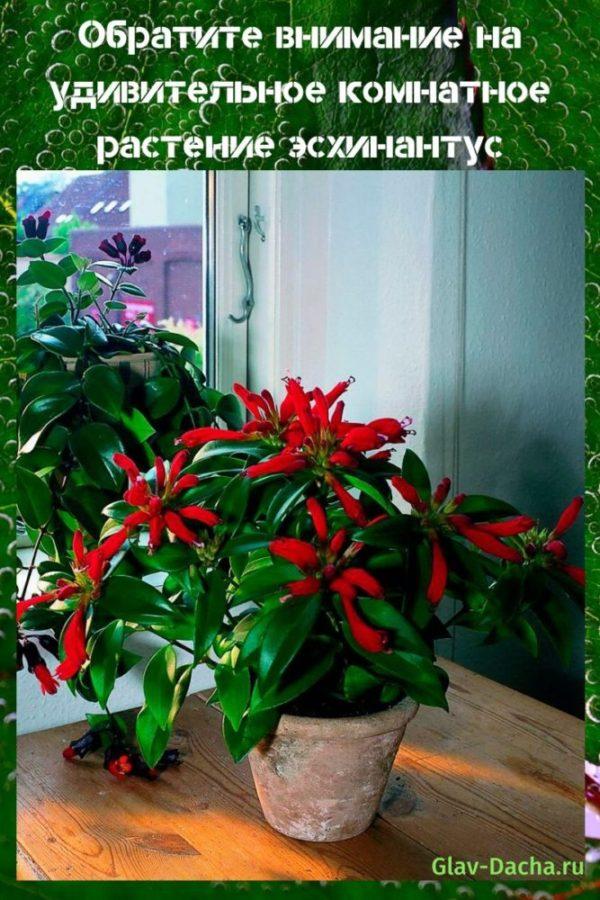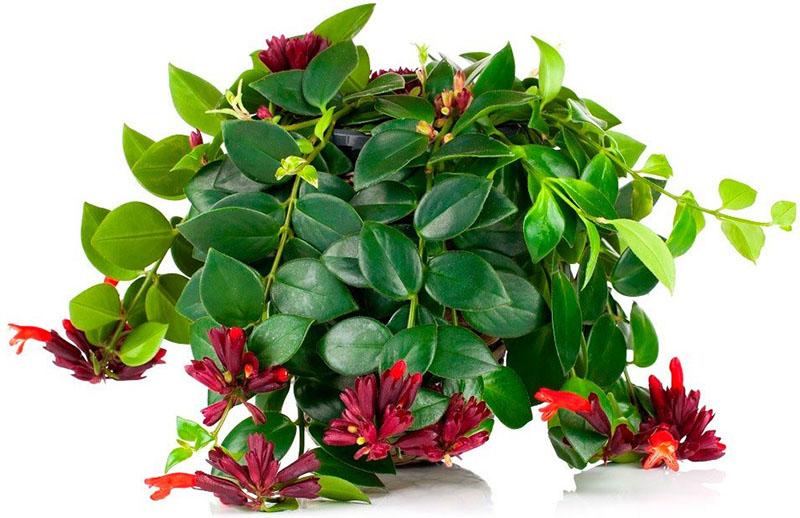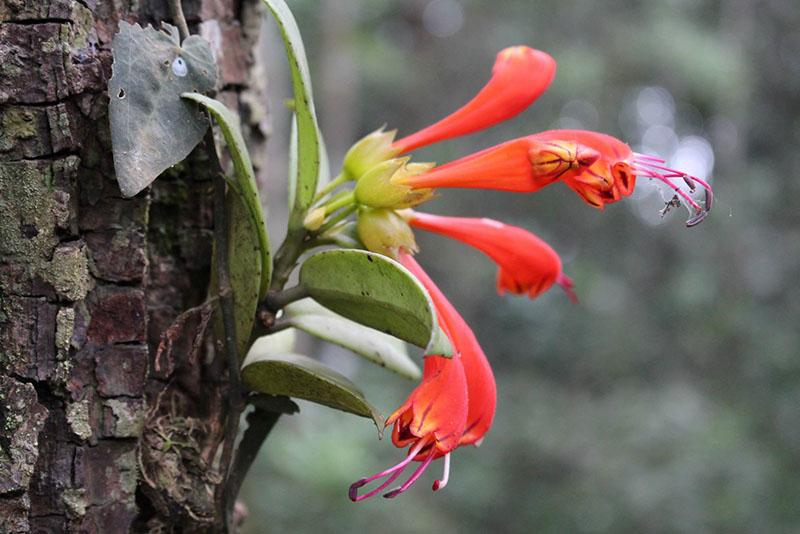Pay attention to the amazing houseplant eschinanthus
 The luxurious houseplant eschinanthus has a special place in the interiors of modern living spaces and offices. Its scarlet buds resemble a magical scarlet flower from a famous fairy tale. Therefore, flora lovers are eager to get the culture for their monastery. What does an overseas flower look like? Why are its varieties attractive? How to care for and propagate a cherished plant at home? We find out the objective opinion of florists.
The luxurious houseplant eschinanthus has a special place in the interiors of modern living spaces and offices. Its scarlet buds resemble a magical scarlet flower from a famous fairy tale. Therefore, flora lovers are eager to get the culture for their monastery. What does an overseas flower look like? Why are its varieties attractive? How to care for and propagate a cherished plant at home? We find out the objective opinion of florists.
The exquisite beauty of a mysterious flower

 If the writer of the famous fairy tale had in mind this particular flower, then he has a very delicate flair. The plant actually grows in the tropical forests of Malaysia. As an ampelous culture, aeschinanthus "settles" on old snags, the trunks of mighty trees or mossy stones. Over time, he envelops his "residence" with strong stems, like a vine. At home, the main shoot of the eschinanthus reaches over 70 cm.
If the writer of the famous fairy tale had in mind this particular flower, then he has a very delicate flair. The plant actually grows in the tropical forests of Malaysia. As an ampelous culture, aeschinanthus "settles" on old snags, the trunks of mighty trees or mossy stones. Over time, he envelops his "residence" with strong stems, like a vine. At home, the main shoot of the eschinanthus reaches over 70 cm.
 Long shoots are strung with leathery leaf plates of a glossy nature. They keep on miniature petioles. The plates have a lanceolate-oval shape and are colored deep green.
Long shoots are strung with leathery leaf plates of a glossy nature. They keep on miniature petioles. The plates have a lanceolate-oval shape and are colored deep green.
At the top of the stems or in the axils of green foliage, buds of an original shape are formed. The tubular corolla has two graceful curves, which gives the flower a fabulous look.
Depending on the variety, the buds are painted in these colors:
- scarlet;
- pink;
- fiery yellow;
- rich burgundy;
- bright orange.
 One inflorescence contains from 6 to 12 graceful "tubes", gracefully directed towards the sky. Over time, instead of bright bouquets, thin pods filled with seeds form on the shoots. Once fully ripe, they crack and the planting material is carried by the wind. According to biologists, there are about 200 species of this culture. Most of them grow in their natural environment. About 10 of them are cultivated indoors. Let's get acquainted with the most popular varieties.
One inflorescence contains from 6 to 12 graceful "tubes", gracefully directed towards the sky. Over time, instead of bright bouquets, thin pods filled with seeds form on the shoots. Once fully ripe, they crack and the planting material is carried by the wind. According to biologists, there are about 200 species of this culture. Most of them grow in their natural environment. About 10 of them are cultivated indoors. Let's get acquainted with the most popular varieties.
Marble
 differs in the original color of dense foliage. Against the dark green background, fanciful patterns formed by yellowish lines stand out. The back of the plate is purple-brown. It is also decorated with a stylish pattern. From the side, Aeschinanthus marble resembles a bush, since it has side shoots. Greenish buds are covered with small brown specks.
differs in the original color of dense foliage. Against the dark green background, fanciful patterns formed by yellowish lines stand out. The back of the plate is purple-brown. It is also decorated with a stylish pattern. From the side, Aeschinanthus marble resembles a bush, since it has side shoots. Greenish buds are covered with small brown specks.
Mona lisa
 A distinctive feature of the species is unpretentiousness. The shoots of the plant are covered with olive-colored foliage. The buds form at the tips of the stems. Their petals are painted in a classic scarlet tone, which is especially popular with fans of indoor crops.
A distinctive feature of the species is unpretentiousness. The shoots of the plant are covered with olive-colored foliage. The buds form at the tips of the stems. Their petals are painted in a classic scarlet tone, which is especially popular with fans of indoor crops.
Lobba
 In nature, the flower was found on the island of Java. It has flexible branches, oppositely covered with oval-shaped dark green foliage. The inflorescences are crowned with graceful vines and are colored deep red. A yellowish tint can be seen inside the "tubes".
In nature, the flower was found on the island of Java. It has flexible branches, oppositely covered with oval-shaped dark green foliage. The inflorescences are crowned with graceful vines and are colored deep red. A yellowish tint can be seen inside the "tubes".
Twister
 The original shape of the leaf blades and shoots is the highlight of this variety. The bush resembles the lush curls of a young girl, decorated with orange flowers.They are located not only at the tips of the shoots, but also in the axils of the leaf plates.
The original shape of the leaf blades and shoots is the highlight of this variety. The bush resembles the lush curls of a young girl, decorated with orange flowers.They are located not only at the tips of the shoots, but also in the axils of the leaf plates.
Houseplant eschinantus: growing secrets
 Getting a tropical crop at home can be tricky. And to make it bloom, you need to create comfortable conditions. Find out what the experts advise.
Getting a tropical crop at home can be tricky. And to make it bloom, you need to create comfortable conditions. Find out what the experts advise.
 Although the Aeschinanthus is native to the tropics, one should not forget that it grows in dense forests. It turns out that culture does not like the abundance of light. Its foliage is afraid of direct sunlight. Often, such "kisses" leave yellow burns on the plates. On the other hand, the lack of light weakens the plant, and it does not throw out the buds. This is one of the main reasons why Aeschinanthus does not bloom at home. If the culture is placed on the south window, then the glass is covered with a white cloth or paper.
Although the Aeschinanthus is native to the tropics, one should not forget that it grows in dense forests. It turns out that culture does not like the abundance of light. Its foliage is afraid of direct sunlight. Often, such "kisses" leave yellow burns on the plates. On the other hand, the lack of light weakens the plant, and it does not throw out the buds. This is one of the main reasons why Aeschinanthus does not bloom at home. If the culture is placed on the south window, then the glass is covered with a white cloth or paper.
Permissible temperature regime
 Do people like the sudden change in the weather? Few people find pleasure in this. Likewise, a flower that comes from a warm region does not tolerate temperature changes. Experienced florists grow the flower indoors, where readings are maintained between 20 and 26 ° C. The temperature is lowered only during the period of bud formation. Usually, the process starts in the winter. Therefore, the culture is taken to a room with a temperature of 15 to 18 ° C.
Do people like the sudden change in the weather? Few people find pleasure in this. Likewise, a flower that comes from a warm region does not tolerate temperature changes. Experienced florists grow the flower indoors, where readings are maintained between 20 and 26 ° C. The temperature is lowered only during the period of bud formation. Usually, the process starts in the winter. Therefore, the culture is taken to a room with a temperature of 15 to 18 ° C.
Fertile substrate
 Despite the fact that in nature the plant "lives" on the trunks of large trees, it needs high-quality soil. Busy people usually buy substrate from the store. And true admirers of flora, prepare the ground for the escinanthus with their own hands.
Despite the fact that in nature the plant "lives" on the trunks of large trees, it needs high-quality soil. Busy people usually buy substrate from the store. And true admirers of flora, prepare the ground for the escinanthus with their own hands.
They use components:
- peat;
- humus;
- leafy ground;
- coarse sand.
Each substance is taken in one part, and the leaf earth is 2 times more. The components are gently mixed, pierced in a heated oven or poured with a solution of potassium permanganate. The resulting substrate is laid out in a pot where an exotic flower will grow.
Reproduction
 Unfortunately, after 5-6 years of life, the escinantus turns into a shapeless plant. Its root area is completely bare, and the branches become very long. Practice shows that even radical pruning does not help a culture to rejuvenate.
Unfortunately, after 5-6 years of life, the escinantus turns into a shapeless plant. Its root area is completely bare, and the branches become very long. Practice shows that even radical pruning does not help a culture to rejuvenate.
Therefore, flower growers propagate it in a suitable way in a timely manner.:
- cuttings;
- layering;
- sowing seeds.
Each of the options has its own advantages. Consider the rules for performing such procedures.
Cuttings
 For successful propagation of Aeschinanthus by cuttings, strong plant tops are used. They must have at least 3 knots with no visible damage. The cuttings are treated with a root growth stimulant. Small containers are filled with a substrate made from peat and sand. Cuttings are placed in the soil. Watered and taken to a room where the temperature is maintained at + 25 ° C or a greenhouse. The roots will appear in at least 1 week. When the first leaf plates are formed, the cuttings are stabbed. The containers are taken out of greenhousesso that they gradually get used to the lower temperature. Fortified bushes are planted in small pots.
For successful propagation of Aeschinanthus by cuttings, strong plant tops are used. They must have at least 3 knots with no visible damage. The cuttings are treated with a root growth stimulant. Small containers are filled with a substrate made from peat and sand. Cuttings are placed in the soil. Watered and taken to a room where the temperature is maintained at + 25 ° C or a greenhouse. The roots will appear in at least 1 week. When the first leaf plates are formed, the cuttings are stabbed. The containers are taken out of greenhousesso that they gradually get used to the lower temperature. Fortified bushes are planted in small pots.
To observe the process, it is advisable to plant the cuttings in transparent cups.
Layers
 In early spring, a container with earth is installed next to an adult Aeschinanthus. A young and strong shoot is chosen on the bush. Gently direct it to the top ball of soil next to the pot. With a piece of wire, the shoot is fixed and abundantly moistened. Soon it will have roots. The young plant is cut off from the mother bush, opening the way for it to "independent life".
In early spring, a container with earth is installed next to an adult Aeschinanthus. A young and strong shoot is chosen on the bush. Gently direct it to the top ball of soil next to the pot. With a piece of wire, the shoot is fixed and abundantly moistened. Soon it will have roots. The young plant is cut off from the mother bush, opening the way for it to "independent life".
Seeds
 The substrate is poured into a container with drainage holes. The top ball is leveled and the seeds are sown. Moisten abundantly with a spray bottle. Cover with glass or foil. The container is placed on a pallet in a warm place. When sprouts appear, the escinanthus dive. Fortified specimens are planted in separate pots.
The substrate is poured into a container with drainage holes. The top ball is leveled and the seeds are sown. Moisten abundantly with a spray bottle. Cover with glass or foil. The container is placed on a pallet in a warm place. When sprouts appear, the escinanthus dive. Fortified specimens are planted in separate pots.
Seedlings should be watered through the tray until greens appear.
Care Algorithm
 Few people can create indoor conditions that resemble the homeland of a tropical guest. In addition, in nature, the flower grows, twisting around the mighty trees, as shown in the photo. Caring for eschinanthus at home requires a special approach. First of all, the culture is placed in a room with high humidity.
Few people can create indoor conditions that resemble the homeland of a tropical guest. In addition, in nature, the flower grows, twisting around the mighty trees, as shown in the photo. Caring for eschinanthus at home requires a special approach. First of all, the culture is placed in a room with high humidity.
If this is not possible, create it artificially:
- use a humidifier;
- place the pot on a pallet with expanded clay or moss;
- regularly spray the foliage from a spray bottle.
Since the room maintains a high level of humidity, the plant is watered once a week. And even then, if the topsoil looks dry.
Excessive watering leads to the formation of yellow spots on the leaf plates and rotting of the root system.
 Top dressing plays an important role in the growing process. It is carried out in the summer and spring months, using ready-made fertilizers for flowering crops. During the period of winter dormancy, the flower is not fed.
Top dressing plays an important role in the growing process. It is carried out in the summer and spring months, using ready-made fertilizers for flowering crops. During the period of winter dormancy, the flower is not fed.
Specialists pay special attention to the diseases and pests of aeschinanthus, which sometimes affect it. For example, gray rot occurs for the following reasons:
- excess moisture;
- draft;
- contaminated soil;
- temperature changes.
 If these factors are ignored, the fungus will penetrate the tissues of the shoots and begin to destroy them. An alarm signal appears on the soil surface - gray mold. Eliminating the causes of the disease and treating the plant with chemicals will help to save the eschinanthus.
If these factors are ignored, the fungus will penetrate the tissues of the shoots and begin to destroy them. An alarm signal appears on the soil surface - gray mold. Eliminating the causes of the disease and treating the plant with chemicals will help to save the eschinanthus.
 The most dangerous insect is the spider mite. Basically, it affects leaf blades. If many punctures are found on the edges, then the pest has taken its position. How to take care of the escinanthus flower during this period, and defeat the enemy? Culture is sent to the "shower". Spider mite does not like a humid environment. The leaves are washed with "hot" water (no more than 45 ° C) or sprayed abundantly several times. As a result, the culture will come to life again, and will delight owners with lush greenery and flowers.
The most dangerous insect is the spider mite. Basically, it affects leaf blades. If many punctures are found on the edges, then the pest has taken its position. How to take care of the escinanthus flower during this period, and defeat the enemy? Culture is sent to the "shower". Spider mite does not like a humid environment. The leaves are washed with "hot" water (no more than 45 ° C) or sprayed abundantly several times. As a result, the culture will come to life again, and will delight owners with lush greenery and flowers.
Everyone can grow an exotic houseplant eschinanthus at home. It is enough to get to know him better. Choose a suitable variety. Understand care and breeding methods. And then a luxurious exotic from warm regions will appear in the house.